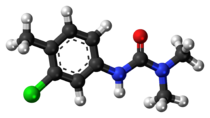
| |

| |
| Names | |
|---|---|
| Preferred IUPAC name
N′-(3-Chloro-4-methylphenyl)-N,N-dimethylurea | |
| Other names
CTU, chlorotoluron, 3-(3-Chloro-4-methylphenyl)-1,1-dimethylurea
| |
| Identifiers | |
3D model (JSmol)
|
|
| ChEBI | |
| ChemSpider | |
| ECHA InfoCard | 100.035.978 |
| EC Number |
|
PubChem CID
|
|
| UNII | |
CompTox Dashboard (EPA)
|
|
| |
| |
| Properties[1] | |
| C10H13ClN2O | |
| Molar mass | 212.67602 |
| Melting point | 148 °C (298 °F; 421 K) |
| log P | 2.41 |
| Hazards[2] | |
| GHS labelling: | |
 
| |
| Warning | |
| H351, H361d, H410 | |
| P201, P202, P273, P281, P308+P313, P391, P405, P501 | |
Except where otherwise noted, data are given for materials in their standard state (at 25 °C [77 °F], 100 kPa).
| |
Chlortoluron, chlorotoluron and CTU are the common names[3] for an organic compound of the phenylurea class of herbicides used to control broadleaf and annual grass weeds in cereal crops.
- ^ EPA Comptox database. "Chlorotoluron". comptox.epa.gov. Retrieved 2021-03-26.
- ^ PubChem database. "Chlorotoluron". pubchem.ncbi.nlm.nih.gov. Retrieved 2021-03-27.
- ^ "Compendium of Pesticide Common Names". alanwood.net.